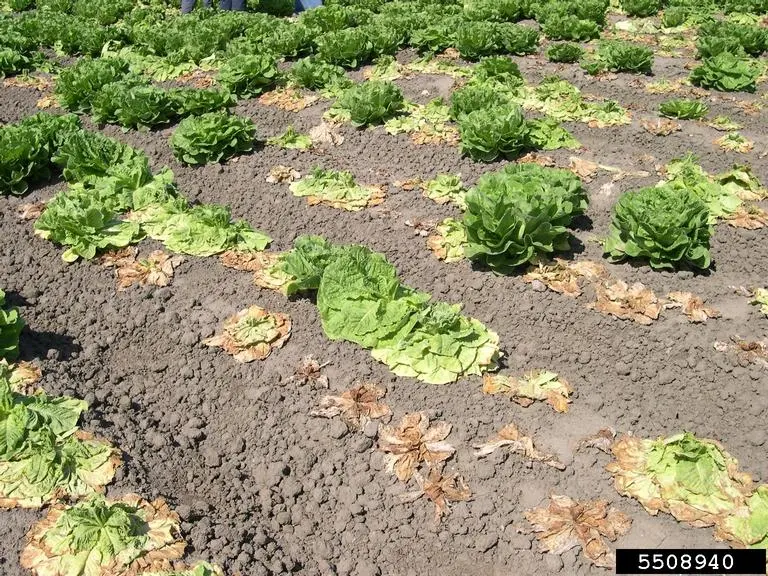Sclerotinia minor
What is Sclerotinia minor?
Sclerotinia minor is a fungal pathogen affecting a wide variety of plants, most notably soybean, lettuce, canola, peanuts, and sunflowers [1–3]. Sclerotinia species, such as Sclerotinia sclerotiorum and Sclerotinia trifoliorum, are responsible for Sclerotinia rots or white moulds, which are of concern to farmers [4]. The infection causes massive economic loss as crops become so severely damaged that they cannot be marketed, while agricultural oilseed and grain crops suffer from lower seed weight, number, or quality [1]. For example, a bad growing year for soybean in the United States had an estimated loss of $560 million USD [5]. There are reports of lettuce farms losing up to 45% of crops in Australia, even if a fungicide spray plan is implemented [6].
Sclerotinia minor is a persistent problem for farmers, as it can survive in the soil for many years outside a host and is challenging to control once it becomes established [7]. Even though Sclerotinia minor has a smaller range of hosts than the more common Sclerotinia sclerotiorum, its symptoms are comparably similar and commonly treated together.
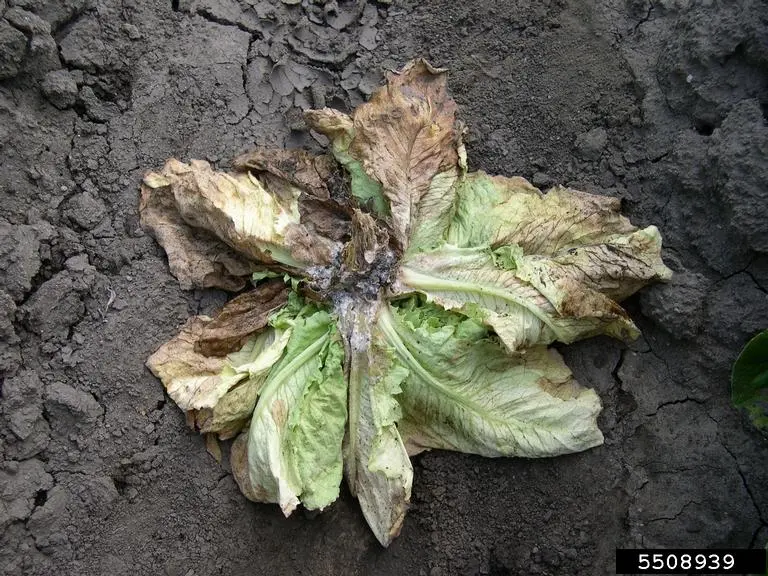
Symptoms of Sclerotinia minor
Sclerotinia rot is a destructive disease affecting many economically important plants, including horticulture, floriculture, and field crops. The symptoms of this disease vary depending on the plant it affects, but some common symptoms include [1–3,7–9]:
- White mould: the characteristic sign of Sclerotinia infection. White, cottony mycelium can be found in or on leaves, stems, flowers, or fruit.
- Wilting or Flagging: apical stems and leaves curl; this is often the first symptom seen.
- Lesions: Lesions usually start as small, circular, water-soaked spots on the leaves and stems. As the disease progresses, these spots enlarge and turn from tan to brown. The lesions may also expand and merge to form large, necrotic areas on the plant.
- Cankers: crown, basal stem, or stem cankers lower turgor pressure and can cause sudden wilting. Note that Sclerotinia minor rarely causes basal stem canker.
- Stem and Crown Rot: Sclerotinia minor can cause rot of the stem and in plants. This can lead to the collapse of the plant and death.
- In lettuce, the roots are infected, which leads to the crown’s rot and decay. Afterwards, the leaves turn brown and collapse.
- Root rot in tomatoes has been reported, especially for crops planted after lettuce.
- Fruit Rot: the pathogen can cause fruit rot, leading to significant economic losses.
- Blight: the pathogen can cause a blight on the leaves and stems of the infected plant, leading to a decline in plant growth and productivity.
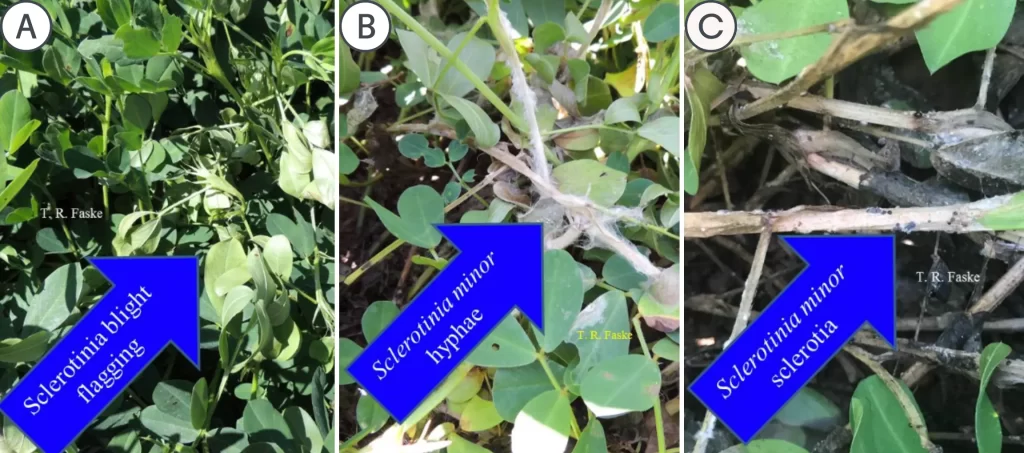
https://www.uaex.uada.edu/farm-ranch/pest-management/plant-disease/field-crop-diseases/peanuts/disease.aspx
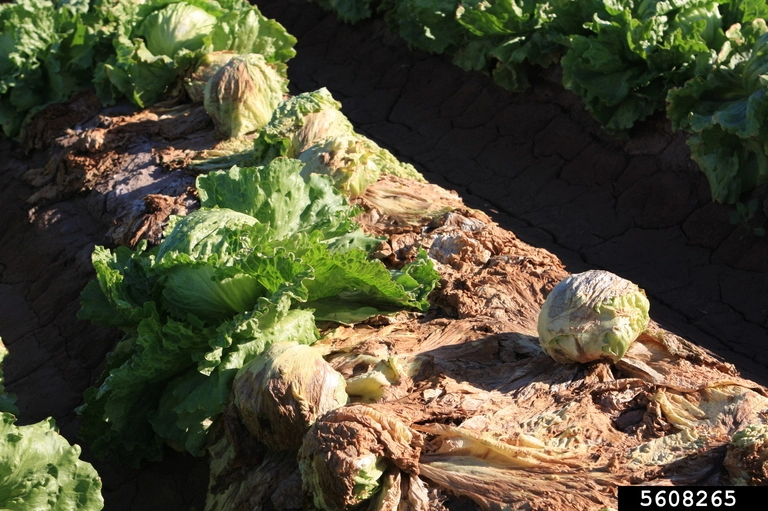
We provide great overviews of many agricultural microorganisms. Subscribe to stay updated!
Life Cycle and Infection Stages
Sclerotinia minor has a complex life cycle, having both sexual and asexual stages. The asexual stage of the disease is indicated by the production of sclerotia, which are hard, compact structures that can persist in the soil for many years. The sexual stage of Sclerotinia minor is described by the production of fruiting bodies, which produce spores that can infect new plants. However, the plant usually infects via sclerotia rather than the spores. [4,8,10,11].
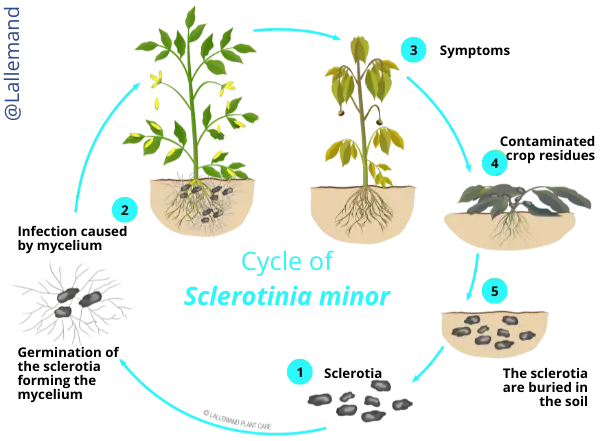
The infection process of Sclerotinia minor occurs when the mycelium or sclerotia comes in contact with a vulnerable host, usually along the soil line. The mycelium or sclerotia then proliferates and invades the susceptible plant, producing more mycelia and infecting the plant. Spores also undergo a similar route of infection. When a spore lands on an exposed host, it germinates, and the mycelium invades the tissue. Once the plant is infected, the fungus produces sclerotia, which can persist in the soil and infect new plants.
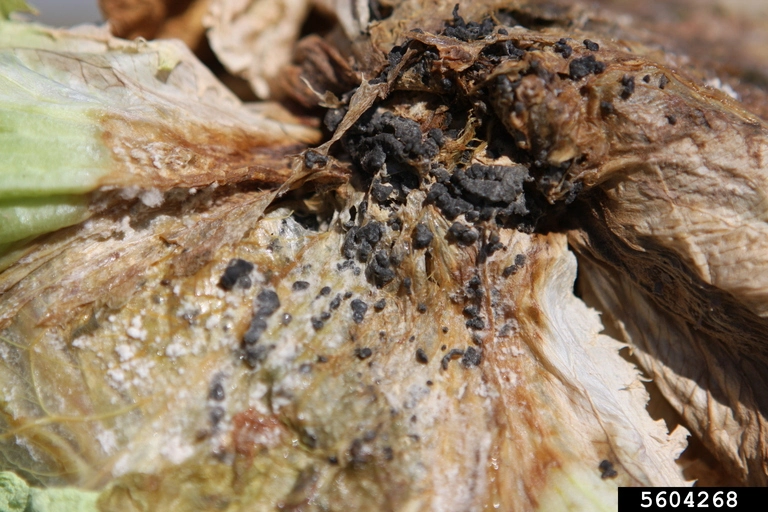
It is worth noting that a Sclerotinia or white mould infection is monocyclic and rarely infects plant-to-plant in the same season. The most disastrous infections are from the sclerotia or mycelia left in the soil, plant debris, or other surfaces from a past season or outside sources. Airborne spores are also a risk but have only been observed occasionally [8].
Growth conditions for Sclerotinia minor
Sclerotinia minor thrives in cool, moist conditions and is most active during spring and fall’s cool, damp periods. The pathogen can also grow in soil high in organic matter and can survive in the soil for many years [3,8,10–12]. Listed are the ideal growing conditions for Sclerotinia minor:
- Usually noted around flowering time
- Commonly found, especially in very wet seasons
- Develops rapidly at 20-25°C (68-77°F), not below 5°C (41°F) or above 30°C (86°F)
- Infections during high relative humidity (95-100%). High relative humidity promotes the germination of mycelia from a sclerotia
Methods of Prevention and Control
Prevention is always the best course of action when dealing with plant diseases like Sclerotinia minor. Here are some methods of prevention and control that can help farmers minimize the risk of infection [3,8,10–12]:
Best Practices
- Regularly check for symptoms and send samples to labs for confirmation.
- Rotating crops can reduce the number of spores of the pathogen in the soil, making it less likely for infections to occur. Consider rotating crops every three years or so, depending on the severity of the problem.
- Maintaining proper plant spacing and proper plant nutrition can help reduce the risk of disease.
- Cleaning up plant debris and removing infected plants from the field can help reduce the spread of the disease. This is particularly important in the case of perennials, where the pathogen can survive for many years in infected plant material.
- Maintaining proper ventilation in greenhouses and fields can help reduce humidity levels, which can contribute to the spread of the disease.
- Using seeds that have been treated to reduce the presence of the pathogen can help prevent the spread of the disease.
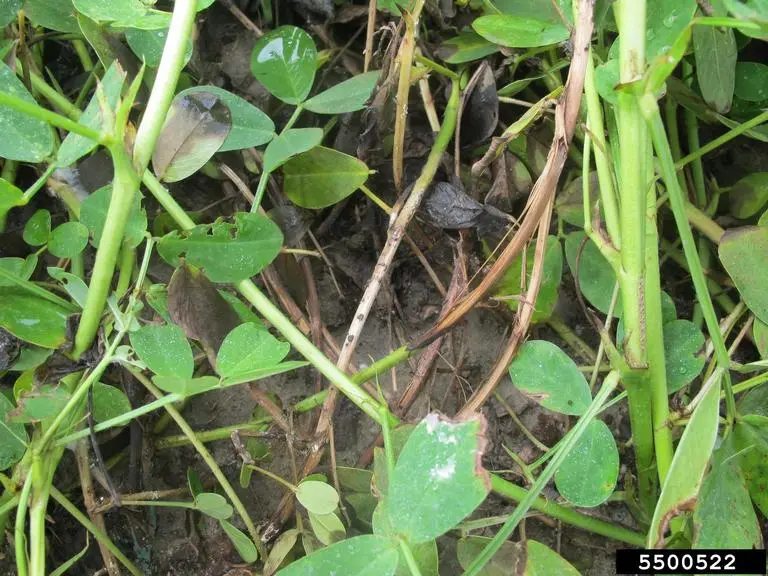
Treatment
- Chemical fungicides can be applied to help control the spread of the disease. Fungicides such as chlorothalonil, mancozeb, and sulfur can be used as preventive measures or to treat infected plants.
- Biofungicides are a newer form of treatment that utilizes beneficial microorganisms to control pathogens. These can be a more environmentally friendly alternative to chemical fungicides but may not be as effective in some cases.
- Seeds can be treated with fungicides before planting to reduce the risk of infection.
It’s important to note that no single treatment method works for all crops or situations, and a combination of the above methods may be necessary for effective control. Consult a professional agronomist for tailored advice specific to your crops and farm.
Conclusion
White mould caused by Sclerotinia minor and other Sclerotinia species is a destructive disease affecting many plants. It is most commonly noted during flowering and develops rapidly in moist, warm conditions. The presence of black sclerotia and white mould in affected areas is diagnostic for the disease. Good crop rotation practices and improved air circulation can help reduce the incidence of white mould. Management strategies also include controlling plant density to reduce extended periods of foliage wetness and checking with a lab to verify the pathogen quickly.
Disclaimer:
The information we present in Pathogen Profile is based on collating published peer-reviewed scientific literature and sources we think are reliable. This is by no means an exhaustive review of pathogens. Pathogen Profile gives a small glimpse of what is known about pathogens. We encourage growers to do more research on the pathogens concerning their crops and hydroponic systems. We are not plant pathologists; thus, the information presented in the Pathogen Profile should not be used as professional advice to treat pathogens or operate your system.
References
- O’Sullivan, C. A., Belt, K., & Thatcher, L. F. (2021). Tackling Control of a Cosmopolitan Phytopathogen: Sclerotinia. In Frontiers in Plant Science (Vol. 12). https://www.frontiersin.org/articles/10.3389/fpls.2021.707509
-
Elmhirst, J. (2022). Canadian plant disease survey 2022 volume 102: disease highlights 2021. Canadian Journal of Plant Pathology, 44(sup1), S1–S187. https://doi.org/10.1080/07060661.2022.2076342
-
Melzer, M. S., Smith, E. A., & Boland, G. J. (1997). Index of plant hosts of Sclerotinia minor. Canadian Journal of Plant Pathology, 19(3), 272–280. https://doi.org/10.1080/07060669709500523
-
LAEMMLEN, F. (2001). Sclerotinia Diseases. University of California, Division of Agriculture and Natural Resources. https://anrcatalog.ucanr.edu/pdf/8042.pdf
-
Peltier, A. J., Bradley, C. A., Chilvers, M. I., Malvick, D. K., Mueller, D. S., Wise, K. A., & Esker, P. D. (2012). Biology, yield loss and control of Sclerotinia stem rot of soybean. Journal of Integrated Pest Management, 3(2), B1–B7. https://doi.org/10.1603/IPM11033
-
Porter, I., Pung, H., Villalta, O., Crnov, R., & Stewart, A. (2002). Development of biological controls for Sclerotinia diseases of horticultural crops in Australasia. 2nd Australasian Lettuce Industry Conference, University of Queensland Gatton Campus. https://ausveg.com.au/app/data/technical-insights/docs/VG00048.pdf
-
Koike, S. T., & Subbarao, K. V. (2007). Sclerotinia Diseases. Agriculture: Cole Crops Pest Management Guidelines. https://ipm.ucanr.edu/agriculture/cole-crops/sclerotinia-diseases/
-
Heffer Link, V., & Johnson, K. B. (2012). White mold (Sclerotinia). APS. https://www.apsnet.org/edcenter/disandpath/fungalasco/pdlessons/Pages/WhiteMold.aspx
-
University of Arkansas DIvision of Agriculture. (n.d.). Peanut Diseases and Control – Sclerotinia blight. Cooperative Extension Service. https://www.uaex.uada.edu/farm-ranch/pest-management/plant-disease/field-crop-diseases/peanuts/disease.aspx
-
Blancard, D. (2012). 2 – Diagnosis of Parasitic and Nonparasitic Diseases (D. B. T.-T. D. (Second E. Blancard (ed.); pp. 35–411). Academic Press. https://doi.org/https://doi.org/10.1016/B978-0-12-387737-6.50002-9
-
OMAFRA. (2009). WHITE MOLD. Onatrio CropIPM. http://www.omafra.gov.on.ca/IPM/english/tomatoes/diseases-and-disorders/white-mold.html#advanced
-
Maas, A. L., Dashiell, K. E., & Melouk, H. A. (2006). Planting Density Influences Disease Incidence and Severity of Sclerotinia Blight in Peanut. Crop Science, 46(3), 1341–1345. https://doi.org/https://doi.org/10.2135/cropsci2005.10-0335
![]()
David Santos is a Biotech and Agriscience Advisor at Healthy Hydroponics


